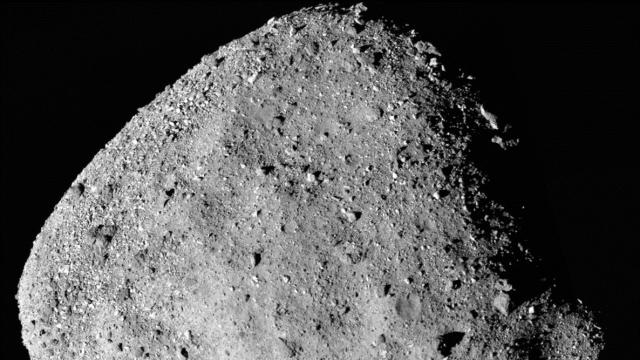NASA’s OSIRIS-REx spacecraft has already detected evidence of water on its target, the asteroid Bennu, just a week after arriving.
The OSIRIS-REx mission’s goals include understanding what kinds of stuff asteroids contain, characterising Bennu’s motion in case its trajectory ever threatens Earth, and learning about what the Solar System was like in its earliest days. The mission even aims to grab a sample of Bennu and bring it back to Earth for further study. Today, NASA announced that OSIRIS-REx has already collected data related to the first and third of those goals by spotting signs of water.
The asteroid doesn’t have liquid water on its surface, notes the NASA press release. Instead, the data suggests that “at some point, Bennu’s rocky material interacted with water.”
The probe, which launched back in 2016, successfully arrived 19km from the 487.68m-wide Bennu last Monday, carrying a suite of instruments it will use to examine the asteroid. Two of those instruments include the Thermal Emission Spectrometer and the Visible and Infrared Spectrometer, which measure the wavelengths of light from of the rock to determine its composition.
Today, scientists behind those instruments have found “hydroxyl groups,” molecules of oxygen and hydrogen bonded together — but rather than existing on their own, they’re likely bonded to Bennu’s clay minerals, according to NASA. Perhaps Bennu once came from a larger asteroid that did contain liquid water.
It’s not a huge surprise. Scientists think that asteroids may have deposited water on our own planet. The largest asteroid in the Solar System, Ceres, is loaded with water.
Water, in fact, is one of the key resources that aspiring asteroid miners hope to gather from asteroids in the future.
Though the probe has only detected hydroxyl groups and not the glorious wet stuff itself, this is still an exciting early milestone for the OSIRIS-REx mission.
OSIRIS-REx is now surveying Bennu to choose an orbital path, and it should begin orbiting the asteroid on December 31. Ultimately, it will attempt to touch the asteroid to gather a sample to bring back to the Earth.
[NASA]
